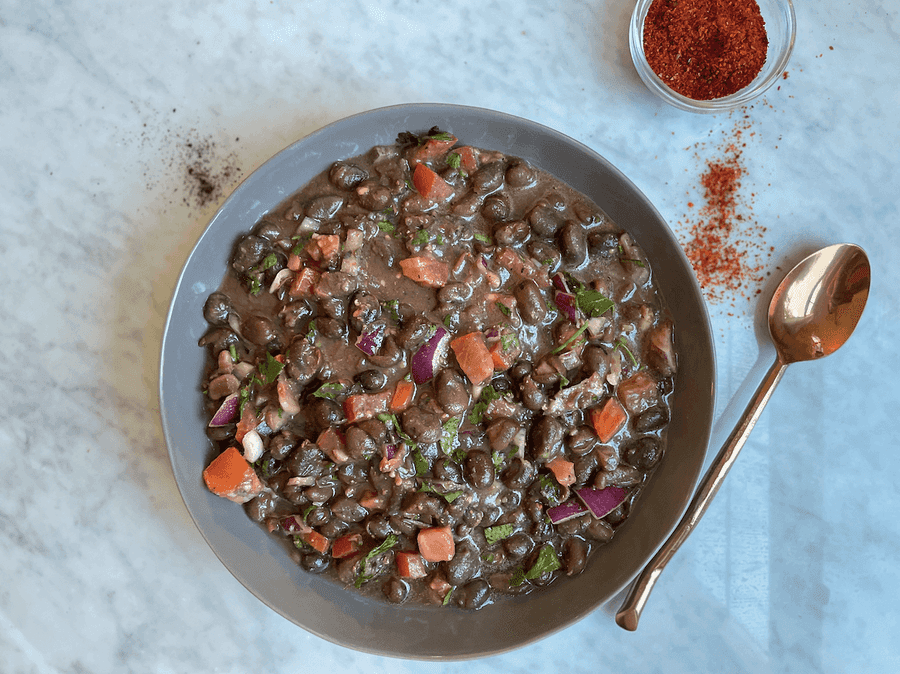Authentic Mediterranean Fava Bean Salad
by Amylee Amos PhD, RDN, IFMCPRecipes
Eat Fool!
Fool, or Ful Medames, is a traditional, middle eastern fava bean dish. Like most all middle eastern food, there are many variations of this recipe that hail from the various regions of the middle east. I have had the pleasure of trying many different types of fool: slathered in creamy tahini, drizzled in sour pomegranate molasses, but they all feature nutrient dense fava beans as the star of the plate. I am sharing my absolute favorite kind of fool in this recipe.
The fava bean is highly underrated and deserves way more attention than it gets. Fava beans, also called broad beans, are extremely nutrient dense, boasting high levels of folate, manganese, copper, zinc, and thiamine among other essential nutrients. They are also rich in prebiotic fiber. This type of fiber and the resistant starch in fava beans feeds our gut microbiome, providing the nutrients to allow the healthy bacteria living in our gut to thrive.
Fava beans have been studied for their impact on cancer cells. Specifically, one study looked at the impact of a lectin in fava beans on its ability to diminish the malignancy of cancer cells (1). This means that a compound found in fava beans can help slow the progression of cancer in colorectal cells. This alone is a great reason to try out this recipe!
Fava beans also have high levels of the amino acid, levodopa (l-dopa), which is the body’s precursor of dopamine, a neurotransmitter in the brain responsible for regulating mood. Fava bean consumption has been shown to increase levodopa levels in the blood (2). Because of this association, researchers are looking into the impact of fava beans on mood. This is interesting in terms of brain health because the primary treatment intervention for neurodegenerative Parkinson’s disease includes l-dopa. Much more research on this subject is needed, and fava beans should not be used in place of medical treatment for any disease or condition, but the theory and basic science are intriguing.
The benefits of fava beans are undeniable, but to be honest, that’s true of beans in general. One longitudinal study investigated the protective dietary predictors of some of the longest lived individuals and they found that legume intake was the only food group that consistently predicted survival in the group studied (3). Additionally, plant based diets have been extensively studied and the research consistently shows decreased chronic disease and mortality associated with high intake of plant based foods, including legumes (4,5).
My point is, you have every health reason to try this delicious dish. Not only are you getting all of the benefits from the fava beans, you’re also getting vitamins, minerals, and phytonutrients from the parsley, tomato, garlic, onions, and spices. Worried that fava beans aren’t your thing? You can easily substitute a different bean and still enjoy this dish. As they say in Arabic, ‘Saha!’ (to your health!).
Ingredients:
- 1 cup dry fava beans (or a 29 oz can*)
- 1 teaspoon baking soda
- 1 ½ cup tomato, chopped
- 1 cup parsley, chopped
- ¾ cup onion, finely chopped
- 4 large cloves garlic, minced
- ⅛ cup fresh lemon juice
- 1 tablespoon Aleppo pepper
- 1 ½ tablespoons ground cumin
- ½ tablespoon sumac
- 1 teaspoon sea salt
- ¼ cup extra virgin olive oil
Directions:
- Soak the dry fava beans in water for 12 hours. Keep an eye on the beans to make sure that they stay fully emerged in water (they will greatly expand as they soak).
- Drain the beans and rinse well.
- Place the fava beans in a pot, cover in fresh water, and add 1 teaspoon of baking soda.
- Boil until soft, approximately 1 hour (though this will depend on the size of the fava beans).
- Add two cups of fresh water and simmer on low for 10 minutes.
- In another bowl, add the tomatoes, parsley, onion, garlic, lemon juice, spices, salt, and olive oil.
- Stir and set the vegetable mixture aside.
- After 10 minutes of simmering, remove the fava beans from the water and place them into the vegetable mixture.
- Add 1 cup of the simmering water (while it is still warm) into vegetable mixture and stir.
- Serve immediately.
Note: If you are using canned fava beans, drain the water from the canned beans, place in a pot, and proceed to step 5.
References:
- Jordinson, M., El-Hariry, I., Calnan, D., Calam, J., & Pignatelli, M. (1999). Vicia faba agglutinin, the lectin present in broad beans, stimulates differentiation of undifferentiated colon cancer cells. Gut, 44(5), 709–714.
- Mohseni-Mehran, S.M., & Golshani, B. (2013). Simultaneous Determination of Levodopa and Carbidopa from Fava Bean, Green Peas and Green Beans by High Performance Liquid Gas Chromatography. Journal of Clinical and Diagnostic Research : JCDR, 7(6), 1004–1007.
- Darmadi-Blackberry, I., Wahlqvist, M.L., Kouris-Blazos, A., Steen, B., Lukito, W., Horie, Y., & Horie, K. (2004). Legumes: the most important dietary predictor of survival in older people of different ethnicities. Asia Pac J Clin Nutr., 13(2), 217-20.
- McEvoy, C., Temple, N., & Woodside, J. (2012). Vegetarian diets, low-meat diets and health: A review. Public Health Nutrition, 15(12), 2287-2294.
- 2.) Orlich, M.J., Singh, P.N., Sabaté, J., et al. (2013). Vegetarian Dietary Patterns and Mortality in Adventist Health Study 2. JAMA Intern Med,173(13):1230–1238.